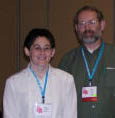
Schutzberg and Bob Gurda at WLIA conference
Geospatial data increases in volume everyday, to the point that our capacity to find what we want has become a problem, especially when multiple copies exist. At the same time, the tools for locating that proverbial needle in a haystack haven’t kept up.
According to Adena Schutzberg, editor of the weekly on-line GIS Monitor, this issue is a crucial one for the community to come to grips with. Especially with the rise of web-based mapping, we risk overloading and confusing many people who we want to be making good use of our data. Schutzberg was a keynote speaker at the Wisconsin Land Information Association’s annual conference held in Wisconsin Dells in early March.
Metadata is critical, as is sharing
Metadata, or “data about data,” is a key to the solution here. Without this documentation, people wanting to use data can’t be confident about their utility, and emerging automated methods for sifting through data to find what might be appropriate to use are likewise at a huge disadvantage.
Similarly, data that are subject to sharing restrictions can’t generate their full potential value. So, making data (and the related metadata) easily available is important.
Keep it simple and straightforward
Schutzberg offered several examples of awkward or partial geospatial data delivery that can cause frustration. Orthophoto images over downtown Washington, D.C. have been selectively blurred to obscure what presumably are sensitive locations on the roofs of the White House and adjacent buildings. However, other sources show these same locations clearly. So, does the blurring provide protection or does it simply draw attention to something that wouldn’t otherwise be obvious?
She also asserted that the quickest and sometimes most comprehensive method for locating geospatial data is through a simple web search such as Google. What you find that way may not be the best or simplest source, but the method is very fast. In this case, Google isn’t actually recognizing geospatial data, but instead is much more crudely finding words on web pages that align with your search criteria.
Portals offer great promise
Until recently, it was next to impossible to deliver geospatial data “just in time” to meet a user’s needs. Accessing desirable data, and only the data needed, simply wasn’t easy. Instead, multiple copies of the same, or slightly altered, data sets sat on servers in a variety of locations, some of which were perhaps known to only a select few individuals. Even if these data sets were fully documented through PGDC standard metadata, it was not easy for a user to differentiate among them, if in fact they were different at all.
Portals based on mapping services will ease this problem, with the data being drawn from multiple sources and presented as a single primary source for users. This improved arrangement increases the chance that the accessible data will be the freshest and best documented. In addition, there can be multiple portals, each configured to meet the needs of a particular audience, yet each portal can draw from the same original sources of data, even though this may not be obvious to the users.
